- What are Legacy Systems and Their Limitations
- Key Complexities and Challenges with Legacy Systems
- Real-World Examples of Industries Facing Challenges with Legacy Systems
- Key Reasons for Companies to Upgrade Their Legacy Applications
- How AI Transforms Legacy Application Modernization
- Applications of AI in Legacy Modernization
- Benefits of AI for Legacy Application Modernization
- How to Implement AI in Legacy Application Modernization
- 1. Assess the Current System
- 2. Choose a Modernization Approach
- 3. Automate System Upgrades
- 4. Integrate AI into Core Business Processes
- 5. Upgrade UX with AI-powered Interfaces
- 6. Strengthen Security and Compliance with AI
- 7. Continuous Learning and Optimization
- 8. Future-Proof Modernization Efforts
- 9. Partner with AI Experts
- Challenges in AI-Driven Legacy Modernization
- Resistance to Change
- Lack of Skilled Resources
- Integration Complexities
- Legacy System Maintenance
- Future Trends in Legacy Modernization with AI
- Modernize Your Legacy Applications with Appinventiv’s AI Excellence
- FAQs
Legacy systems are the silent roadblocks of modern enterprise expansion. While they once facilitated innovation, today, they often hinder progress, creating operational silos, security vulnerabilities, and skyrocketing maintenance costs.
According to Computer Weekly, legacy systems hold back nearly 90% of organizations, directly hampering their ability to innovate and expand.
For instance, a customer walks away from a financial institution that fails to keep pace with modern technologies as outdated systems cannot process their requests as fast as a rival FinTech company. Scenarios like this are not rare. Similar challenges plague every industry daily, frustrating customers and staff alike to enjoy seamless digital experiences.
The urgency for legacy application modernization has never been greater. It has become a dire necessity for survival, growth, agility, and innovation.
But how do you effectively upgrade systems built for an entirely different era?
Among the various approaches, AI for legacy application modernization is leading the charge because it is not just about upgrading the legacy systems but also about how quickly you leverage the latest technologies to avoid being left behind. Artificial intelligence in legacy application modernization enables companies to transform their systems rapidly without disrupting their day-to-day operations.
Curious to know more about the role of AI in legacy application modernization? Go through this blog to discover how AI in legacy modernization can help you move from limitation to liberation, ensuring your organization thrives in today’s fast-paced digital landscape.
Unlock the potential of your business with modernized AI applications.
What are Legacy Systems and Their Limitations
A legacy system refers to outdated software or hardware that lacks the scalability, flexibility, and integration capabilities required to thrive in a digital-first economy. However, despite its limitations, many organizations still count on them to fulfill their critical business functions. Why? The reason is obvious; they are familiar, and there is the risk of disrupting critical operational processes. They know legacy system modernization is crucial to business survival, yet they delay it due to perceived complexities, challenges, and costs.
Key Complexities and Challenges with Legacy Systems
- Compatibility Challenges: Legacy systems often fail to integrate with modern software. This creates data silos and reduces operational efficiency.
- Security Risks: Older systems lack robust security measures, making them vulnerable to cyberattacks.
- High Maintenance Costs: As technology evolves, maintaining legacy systems becomes increasingly expensive due to scarce expertise and outdated components.
- User Dissatisfaction: Outdated interfaces and slow processing times lead to poor user experiences and frustration for customers and companies alike.
- Compliance Requirements: Legacy systems do not align with evolving regulatory compliances, such as GDPR or HIPAA, exposing businesses to legal risks and fines.
Real-World Examples of Industries Facing Challenges with Legacy Systems
Legacy systems are the backbone of many businesses, but their limitations often lead to significant operational challenges. These outdated systems are difficult to scale, expensive to maintain, and lack the flexibility required to integrate with modern technologies. Let’s talk about some examples of industries that face challenges with legacy systems:
Banking
Banks using decades-old mainframe systems struggle to implement real-time transaction processing, frustrating customers accustomed to instant services.
Healthcare
Legacy systems in healthcare, such as electronic medical records (EMRs), create data silos, making it difficult for professionals to access and share critical patient information.
Retail and eCommerce
Retailers face challenges in providing personalized customer experiences because their systems cannot handle real-time analytics. These inefficiencies, high costs, and limited agility hinder businesses from adapting to rapidly evolving market demands.
Key Reasons for Companies to Upgrade Their Legacy Applications
Legacy app modernization becomes necessary for businesses when outdated systems hinder, rather than empower, teams in achieving their goals. At an organizational level, modernizing these systems enables enterprises to unlock operational efficiencies, boost productivity, and support data-driven decision-making. It also positions businesses to adapt to evolving market demands, integrate advanced technologies, and ensure compliance with regulatory standards.
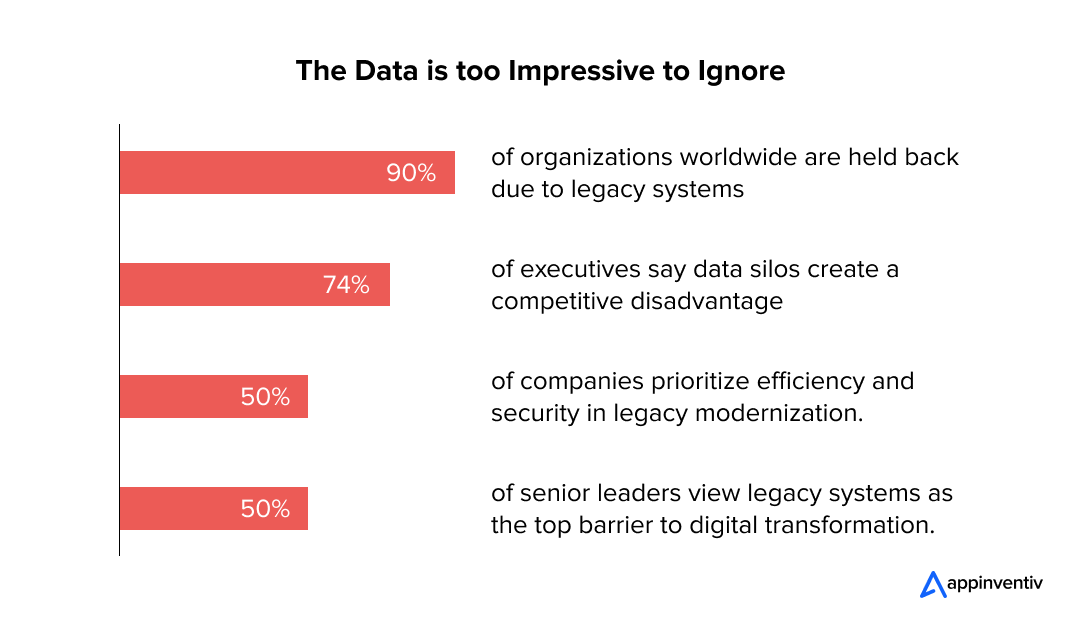
According to Statista, the primary drivers for legacy modernization are enhanced security (58%), improved operational efficiency (54%), cost savings (49%), seamless integration with modern technologies (46%), and greater scalability and flexibility (41%).
In short, as the gap between outdated systems and advanced technologies continues to widen, legacy app modernization with AI solutions for legacy systems has become increasingly important. Outdated systems aggravate inefficiencies, worsen security, increase maintenance costs, and hinder an organization’s ability to meet customer expectations. Delaying modernization only intensifies these challenges, making the transition more complex, expensive, and disruptive over time. Yet, modernization is inevitable!
How AI Transforms Legacy Application Modernization
Artificial intelligence for legacy application modernization bridges the gap between outdated systems and modern business requirements. Thanks to its transformative applications and advantages. It efficiently addresses the limitations of legacy applications, ensuring they remain relevant and competitive in a rapidly evolving digital landscape. Here are some of the most common advantages and applications of AI in legacy app modernization:
Applications of AI in Legacy Modernization
AI solutions for legacy systems plays a transformative role, offering applications that enhance functionality and address long-standing limitations. Below are the key use cases of AI in legacy modernization:
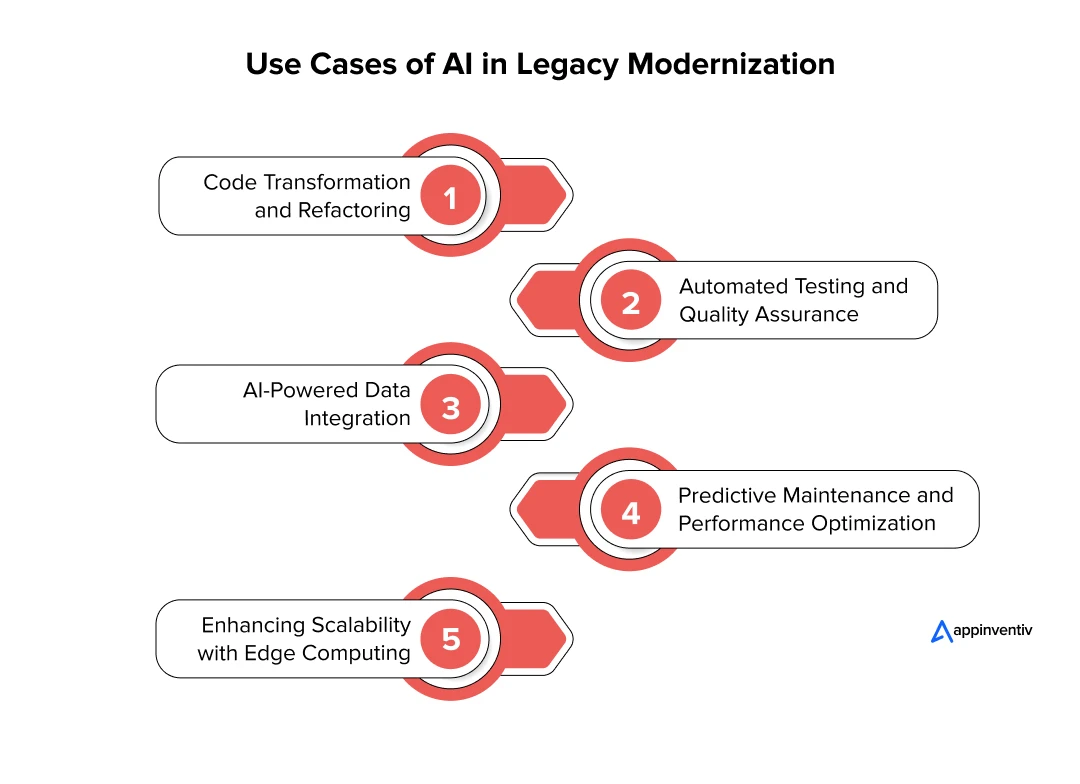
1. Code Transformation and Refactoring
AI-powered tools analyze legacy code, identify inefficiencies, and refactor it to align with modern standards. For instance, Generative AI models for business can translate outdated programming languages into scalable, cloud-compatible code with minimal manual intervention. This reduces the need for time-consuming and error-prone manual rewriting.
A GitHub survey reveals that 92% of US developers already use AI code assistants professionally and personally. Additionally, 70% of these developers report that such tools provide them a competitive edge at work.
2. Automated Testing and Quality Assurance
Testing is essential for legacy app modernization, and AI plays a critical role. Traditional testing methods can be slow and resource-intensive, but an AI-driven approach accelerates much of the testing process. AI for legacy application modernization streamlines regression testing and identifies issues faster by analyzing code for vulnerabilities and automating test scripts. This allows businesses to achieve exhaustive test coverage in a fraction of the time and ensures higher-quality updates.
Artificial intelligence in legacy application modernization identifies critical bugs and performance issues early. This reduces the risk of app transition with hidden defects and makes the modernization process more reliable.
3. AI-Powered Data Integration
AI simplifies the challenge of connecting legacy systems to modern platforms by intelligently consolidating diverse data sources. This improves interoperability and ensures smoother data flow across the organizations. This enables businesses to unlock deeper insights through advanced AI analytics.
4. Predictive Maintenance and Performance Optimization
AI tools monitor system performance in real-time. This empowers businesses to predict and prevent failures before they occur. By providing actionable insights and optimization suggestions, AI helps maintain seamless functionality, minimizing disruptions and maximizing efficiency.
5. Enhancing Scalability with Edge Computing
Modernizing legacy applications goes beyond app upgrades; it requires systems to handle evolving business demands. AI helps optimize applications for edge computing, enabling faster data processing, reducing latency, and supporting efficient scalability. This adaptability is essential in a fast-paced market where seamless product performance is key to customer satisfaction and operational success.
Benefits of AI for Legacy Application Modernization
The role of AI in legacy application modernization goes far beyond updating outdated systems. This also positions organizations for long-term growth and technological advancement. Here are some of the most integral benefits of artificial intelligence for legacy application modernization:
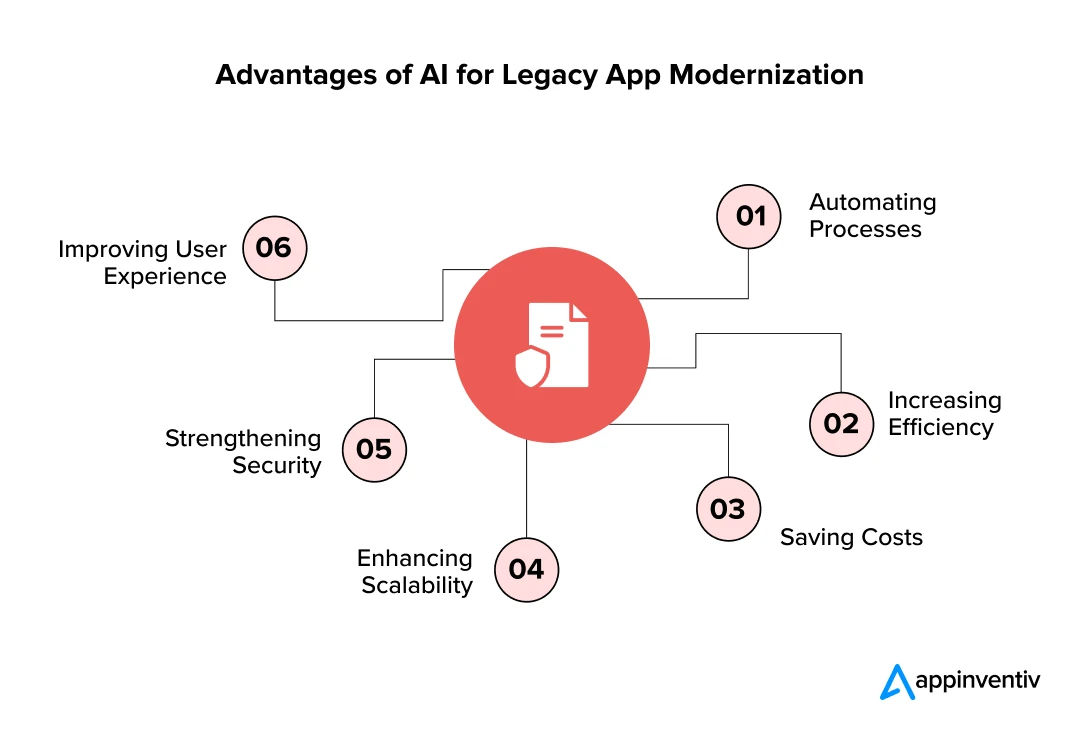
1. Automating Processes
AI-powered tools automate tedious and time-consuming tasks such as code refactoring, data migration, and system testing. This efficiently reduces the time and effort involved in the legacy app modernization process.
2. Increasing Efficiency
Since AI for legacy application modernization automates routine tasks and streamlines processes, this efficiently accelerates modernization timelines, reduces the risk of manual errors, and drives efficiency.
3. Saving Costs
Legacy app modernization with AI minimizes the need for extensive manual intervention in code rewriting, testing, and system integration. This helps cut down overall modernization costs.
4. Enhancing Scalability
AI enables legacy systems to scale automatically as your business grows. This facilitates the integration of new technologies like IoT, cloud computing, and edge computing.
Also Read: Transforming Legacy Systems with Cloud Migration: The Why’s and How’s
5. Strengthening Security
AI in legacy application modernization strengthens system security by identifying vulnerabilities, detecting threats in real-time, and automating compliance measures to meet industry regulations.
Here are some of the most integral security benefits of updating legacy applications with AI:
- Better protection and privacy of sensitive data
- Efficient compliance adherence with industry regulations
- Reduced risk of data breaches and cyber attacks
Improving User Experience
You can integrate AI-powered interfaces, such as chatbots and virtual assistants, into legacy systems to provide users with intuitive interactions. This reduces system complexity and improves user experience.
How to Implement AI in Legacy Application Modernization
Implementing AI in legacy application modernization is a crucial yet complex process that involves the meticulous execution of several key steps. Here are the key steps to integrate AI into legacy systems.
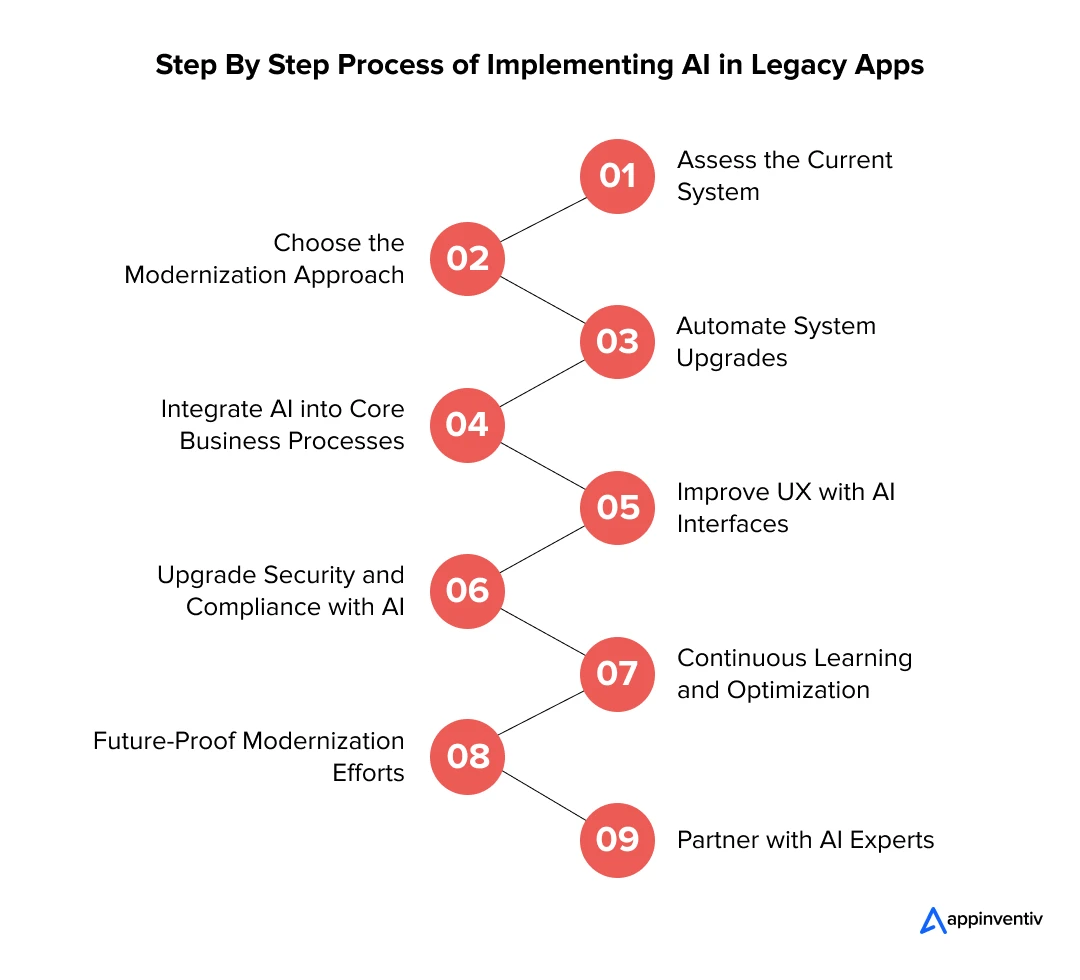
1. Assess the Current System
Before diving deep into modernization, it is essential to evaluate the current state of your legacy system. Thus, you must thoroughly assess the legacy systems to analyze performance bottlenecks, inefficiencies, dependencies, limitations, and potential integration challenges.
This step is integral to understanding which areas call for immediate attention and which can remain untouched. This initial assessment is crucial for identifying the compatibility of the legacy system with AI tools and laying the foundation for an effective modernization journey.
2. Choose a Modernization Approach
Selecting the right modernization approach is crucial to the success of any legacy system transformation. Thus, based on your specific business needs and system complexity, you must choose the right strategy, such as rehosting, refactoring, rearchitecting, or rebuilding. A clear strategy ensures minimal disruption and maximizes the long-term value of modernization efforts.
Legacy app modernization strategies typically revolve around the 7 Rs, each offering a distinct approach to transforming legacy systems.
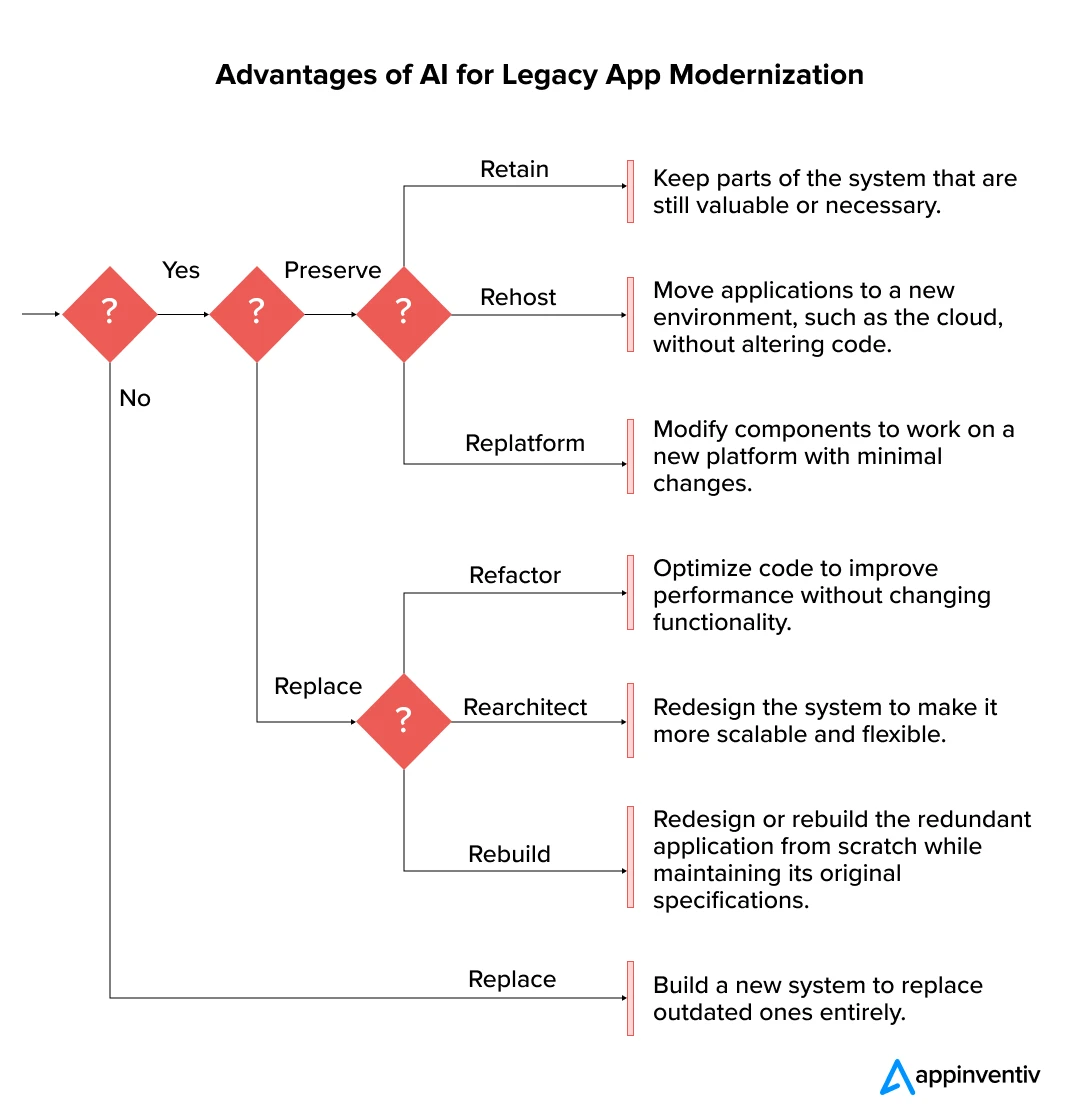
3. Automate System Upgrades
One of the most known applications of AI for legacy system modernization is its ability to automate tedious and time-consuming tasks. AI tools can identify code improvements, suggest optimizations, and even handle system upgrades autonomously.
Additionally, machine learning algorithms help automate regression testing and system integration, ensuring the updated system works seamlessly across various touchpoints. This reduces the manual effort and speeds up the modernization process, minimizing costs and disruptions.
Generative AI in legacy modernization further revolutionizes this process by translating outdated programming languages into modern, scalable ones. These AI-driven models can read and convert legacy code, eliminating the need for manual intervention and the risk of errors.
By automating this translation, generative AI speeds up the legacy system upgrade timeline without compromising quality or functionality. This ensures that systems are more adaptable and aligned with current technology standards.
4. Integrate AI into Core Business Processes
AI can significantly enhance the functionality of legacy systems by integrating smart capabilities into business processes. However, not all aspects of outdated infrastructure require immediate attention. Thus, you should prioritize modernizing the core business processes first. For instance, you can implement AI in core areas like supply chain optimization, customer support automation, fraud detection, inventory management, etc.
5. Upgrade UX with AI-powered Interfaces
Legacy systems often suffer from outdated user interfaces that make operations inefficient. AI can enhance the user experience (UX) by implementing intelligent interfaces such as chatbots, voice assistants, or NLP (Natural Language Processing) capabilities.
These AI-driven tools provide users with quick, easy, and intuitive interactions, making complex tasks easier to execute. By improving UX, businesses can increase employee productivity, reduce human error, and enhance customer experience.
6. Strengthen Security and Compliance with AI
In today’s fast-paced digital landscape, the risks of data breaches and cyber-attacks are at their highest peak. Therefore, businesses still relying on outdated systems and security measures face serious risks. AI can play a pivotal role in upgrading security and ensuring compliance with industry standards.
AI-driven applications help detect anomalies in real-time, predict potential security threats, and automatically take corrective actions. Moreover, AI can help automate compliance reporting, ensuring that your legacy systems meet the latest regulatory requirements without extensive manual input.
7. Continuous Learning and Optimization
AI in apps enables continuous learning and long-term value generation, ensuring your modernized legacy system remains adaptable to changing business needs and market demands. This adaptive nature of AI helps businesses stay ahead of issues, prevent downtime, and improve system efficiency over time. With AI in place, legacy systems evolve constantly to meet new challenges, ensuring optimal performance without significant manual intervention.
8. Future-Proof Modernization Efforts
AI not only modernizes existing systems but also lays the groundwork for future updates and expansions. By integrating AI into your modernization strategy, you don’t just upgrade your current infrastructure but also build a scalable system that can easily accommodate emerging technologies and user demands. This forward-thinking approach helps businesses stay competitive and adapt to future advancements rapidly.
9. Partner with AI Experts
Successfully implementing AI in legacy modernization requires the proven expertise of an artificial intelligence development company specializing in legacy system management and cutting-edge AI app development. Collaborating with AI experts can accelerate the process and ensure that the integration is both seamless and sustainable. These experts can provide valuable insights and support to navigate the complexities of AI-driven modernization, ensuring that the updated systems align with your business goals.
Don’t let legacy systems hamper your growth potential. Leverage our AI excellence to modernize your legacy apps and propel your business forward.
Challenges in AI-Driven Legacy Modernization
While several advantages and applications of AI in legacy modernization are apparent, businesses face some critical challenges in implementing it smoothly. Don’t let these challenges hamper your digital transformation journey. Navigate the potential challenges with strategic solutions to ensure a successful transition.
Resistance to Change
Challenge: Employees and stakeholders may resist adopting AI-driven processes due to fear of disruption or a lack of understanding about the technology.
Solution: To ease the transition, thorough training and clear communication about AI’s long-term benefits for legacy application modernization can be provided.
Lack of Skilled Resources
Challenge: Finding professionals with the right blend of AI expertise and legacy system knowledge can be a real pain, slowing down modernization.
Solution: Organizations can collaborate with AI service providers who bring the required skills and experience to the table.
Integration Complexities
Challenge: Legacy systems are often incompatible with modern technologies. This makes it intimidating to ensure smooth integration with new AI tools.
Solution: Adopting hybrid architectures and AI-driven middleware can simplify integration by bridging the gap between old and new systems.
Legacy System Maintenance
Challenge: Maintaining outdated systems while transitioning to AI-powered solutions can lead to operational inefficiencies and higher costs.
Solution: Phased migration, where legacy systems are updated incrementally, reduces disruption and ensures business continuity.
Future Trends in Legacy Modernization with AI
AI is a sureshot strategy to upgrade legacy apps coupled with several emerging trends. For instance:
AI-powered low-code and no-code platforms empower organizations to modernize systems faster with minimal technical expertise. These tools democratize AI implementation, facilitating IT teams to make meaningful upgrades without extensive coding.
AI’s integration with technologies like cloud computing and edge analytics is another significant trend in legacy product modernization. This combination enhances data processing capabilities, improves scalability, and facilitates real-time insights. This makes legacy systems more agile and responsive.
Given the ever-increasing prevalence of AI and its subset technologies, such as:
The next decade will likely see a surge in autonomous AI systems that handle end-to-end modernization processes in legacy modernization. Organizations will also increasingly adopt emerging trends that ensure that their systems are modernized and optimized for future demands.
These technological advancements will redefine how businesses approach legacy systems and upgrade them for innovation and efficiency.
Modernize Your Legacy Applications with Appinventiv’s AI Excellence
At Appinventiv, we understand the challenges of modernizing legacy apps and the crucial role AI plays in transforming these systems into future-ready solutions. Our team of 1600+ tech experts specializes in AI app development and legacy system management, helping businesses streamline their processes, enhance performance, and ensure scalability.
Whether you want to update your legacy system, optimize system performance, build a new solution, improve data integration, or redesign the enterprise system, we can help you achieve your short-term and long-term goals.
With our legacy app modernization services, your systems will not only be modernized but will evolve to meet the demands of tomorrow’s market.
Partner with Appinventiv today to unlock the full potential of AI for legacy application modernization and stay ahead in the competitive landscape.
FAQs
Q. How do we identify AI solutions for legacy systems?
A. Legacy systems often rely on outdated tech stacks like Delphi, Object Pascal, Fortran, Perl, COBOL, C, Visual Basic, and .Net. While there is nothing wrong with using these tech stacks, often over-reliance on such tech stacks can make you encounter several problems, such as:
- The app fails to meet evolving business needs and objectives.
- The cost of maintenance is too high.
- The system causes frequent errors.
- It does not get security updates.
- It does not function well with modern systems.
- It takes time to load or run and has several redundant features.
- Facing difficulties in finding trusted tech vendors for support and maintenance.
So, if you also face such problems with your existing systems, it is time to leverage artificial intelligence in legacy application modernization.
Q. What are some common challenges with legacy systems?
A. Some of the most known challenges with AI solutions for legacy systems include but are not limited to:
- Security vulnerabilities due to lack of updates
- Compliance risks with current industry regulations
- High maintenance costs due to specialized skills required
- Lack of skilled IT professionals for app maintenance and modernization
- Data silos and reduced information sharing
- Integration issues with the latest technologies
Q. How do AI solutions for legacy systems accelerate app and product modernization?
A. The traditional legacy app and product modernization methods are time-consuming and resource-intensive. However, AI for legacy product modernization accelerates this process with its efficient automation capabilities.
Remember, AI’s true potential lies in its right implementation. Therefore, when AI’s capabilities are combined with human expertise, magic can be created that efficiently accelerates legacy app modernization without defects and disruption while ensuring long-term success.


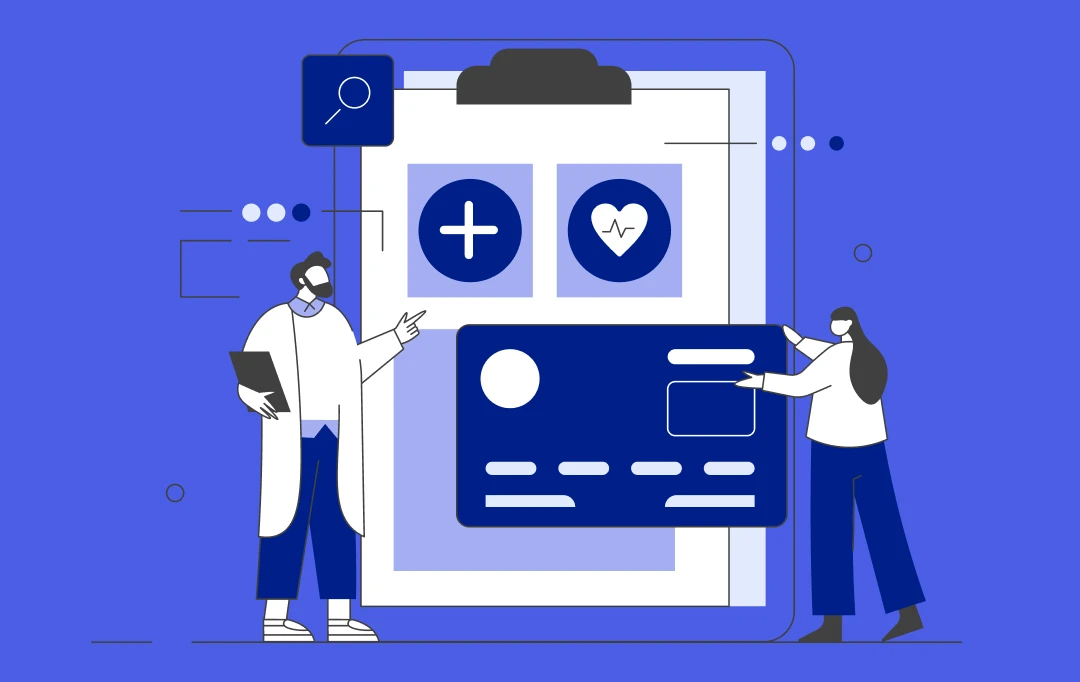
10 Ways AI is Transforming the Healthcare Sector in Australia
Key takeaways: Generative AI could add $13 billion annually to Australia’s healthcare sector by 2030. AI is already transforming operations across diagnostics, admin tasks, and patient care. Healthcare in remote areas is improving with AI-powered virtual assistants and monitoring tools. AI can help address workforce shortages by automating routine tasks and supporting clinical decisions. Major…
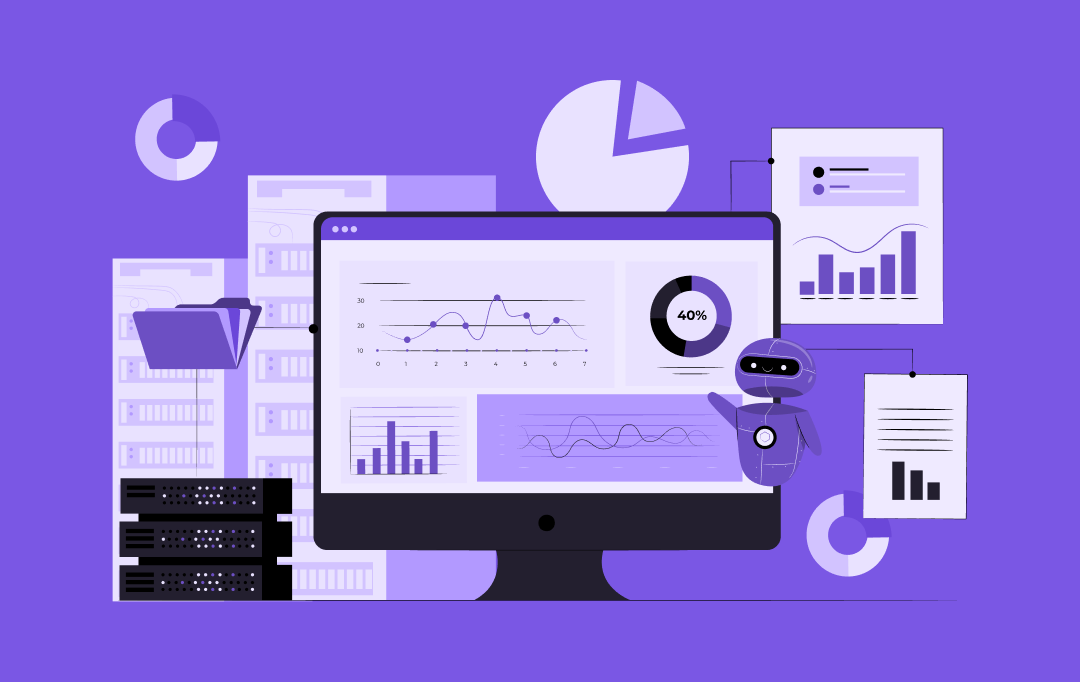
Exploring the Power of AI in Creating Dynamic & Interactive Data Visualizations
Key takeaways: AI transforms data visualization by providing automated insights, interactive dashboards, and NLP, thereby tackling revenue loss and improving data quality. Key features include predictive analytics, real-time data integration, and user-friendly visualizations, enabling faster and more informed decisions. Top 2025 tools, such as Tableau, Power BI, and Julius AI, offer NLP and real-time analytics…
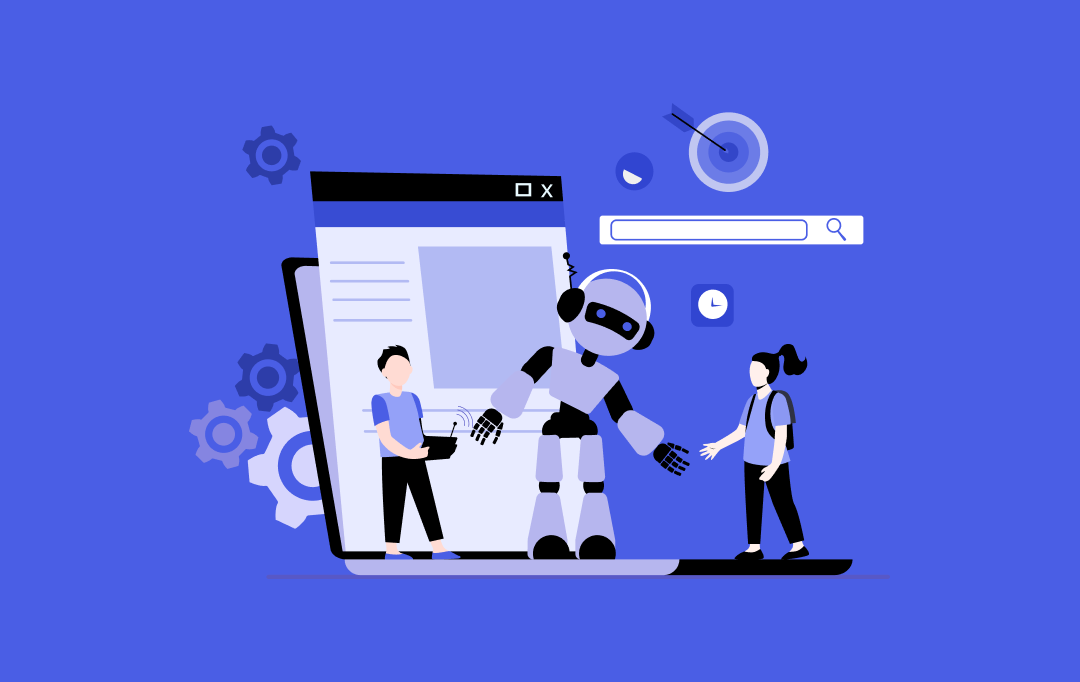
Practical Applications of AI as a Service for Your Business
Key takeaways: AIaaS enables fast, infrastructure-free AI adoption. Used across industries for automation and insights. Real-world examples show proven business impact. Pilot-first approach ensures smooth implementation. Key challenges include data, cost, and scaling. Trends include ethical AI, edge, and SME growth Imagine being able to cut down your operational costs while simultaneously improving decision-making and…

















